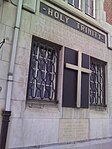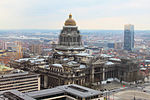Louise/Louiza metro station
1985 establishments in BelgiumBelgian railway station stubsBrussels Metro stubsBrussels metro stationsCity of Brussels ... and 1 more
Railway stations opened in 1985

Louise (French) or Louiza (Dutch) is a Brussels metro station on the southern segment of lines 2 and 6. It opened on 19 August 1985 and is located under the small ring at the Place Louise/Louizaplein, at the end of Avenue Louise/Louizalaan, in the municipality of the City of Brussels (Belgium). The station hosted the shots of the video clip for the Stromae song "Formidable" in 2013.
Excerpt from the Wikipedia article Louise/Louiza metro station (License: CC BY-SA 3.0, Authors, Images).Louise/Louiza metro station
Galerie de la Porte Louise - Galerij van de Louizapoort,
Geographical coordinates (GPS) Address Nearby Places Show on map
Geographical coordinates (GPS)
| Latitude | Longitude |
|---|---|
| N 50.835833333333 ° | E 4.3552777777778 ° |
Address
Tunnel Louise - Louizatunnel
Galerie de la Porte Louise - Galerij van de Louizapoort
1060
Belgium
Open on Google Maps










